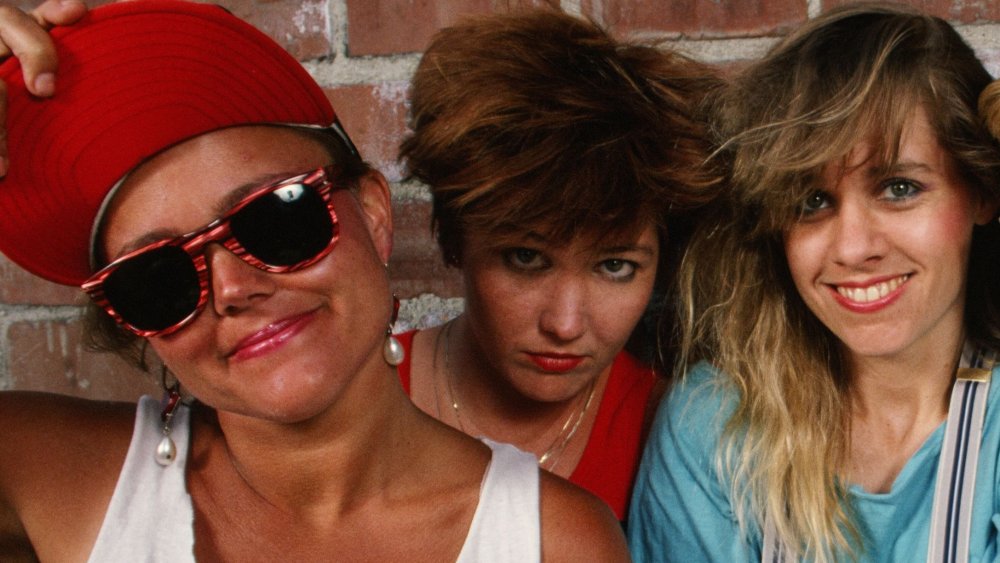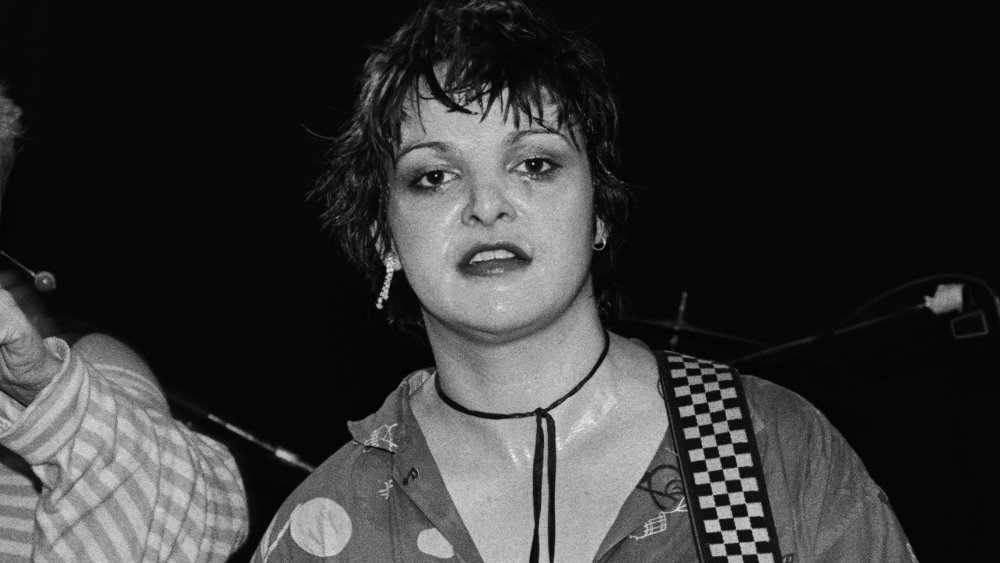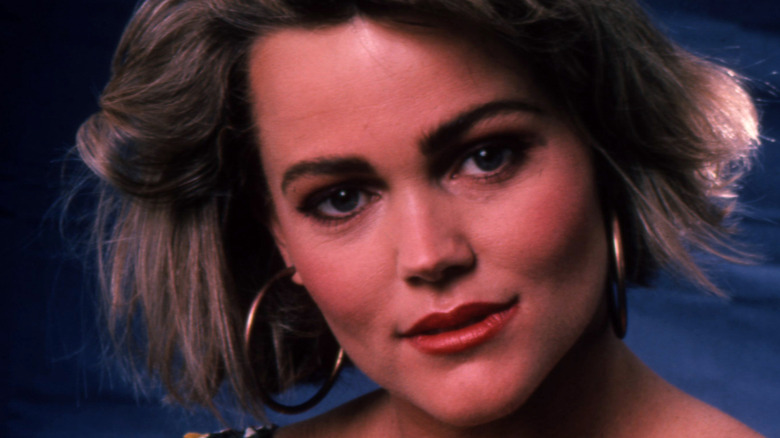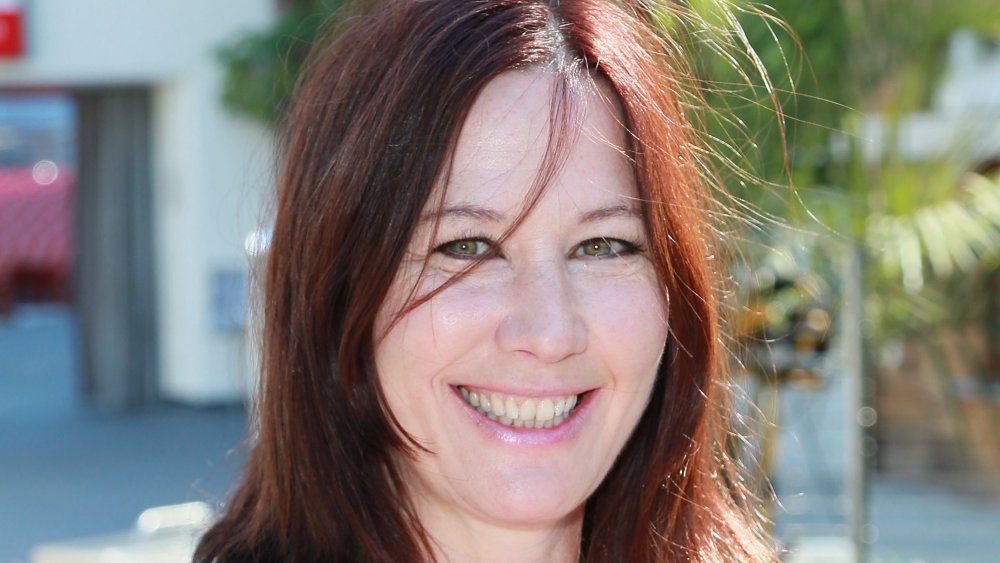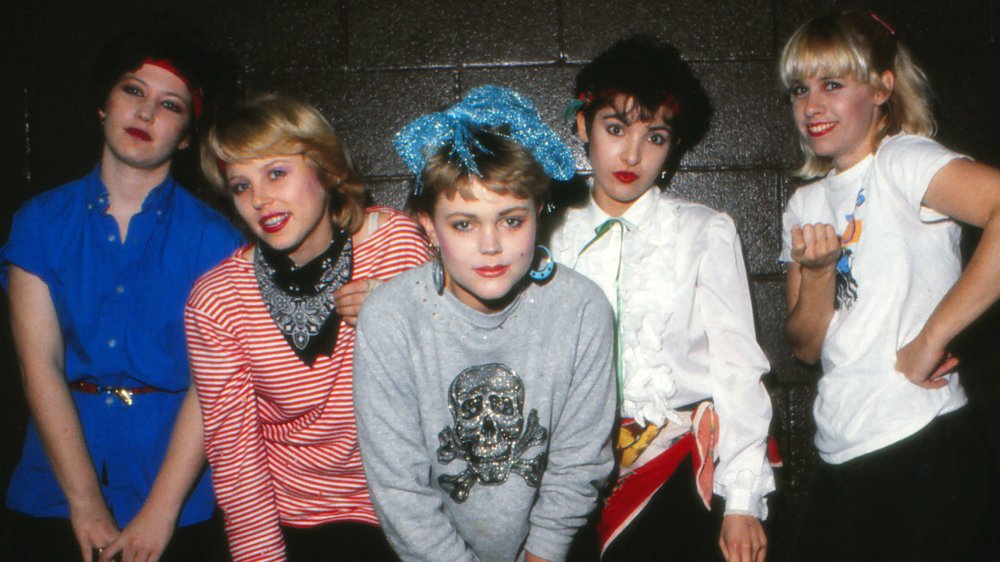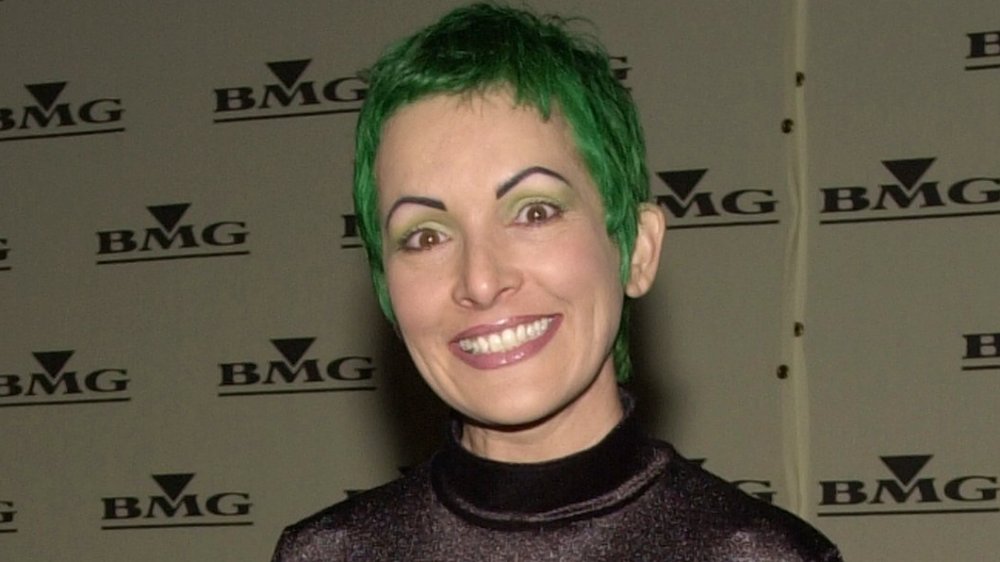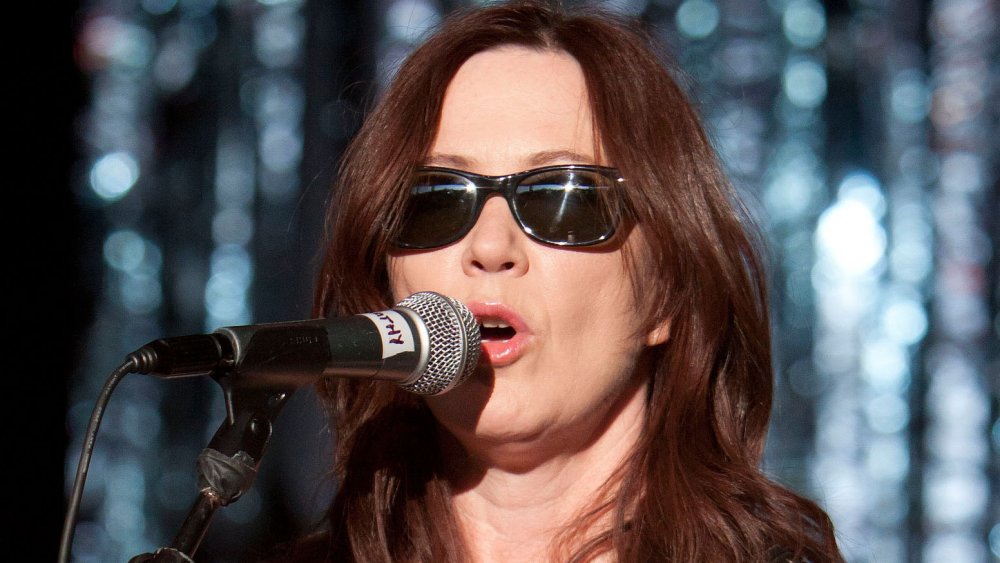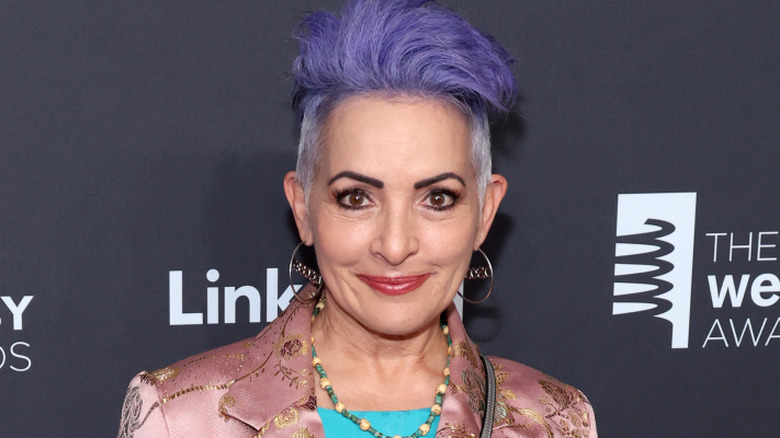The Tragic Real-Life Story Of The Go-Go's
"Girl groups" or female vocal trios have been a part of American pop music for most of the 20th century, but it took until 1981 for a rock band consisting entirely of women, who played their own instruments and wrote their own material, to score a No. 1 album. The record was "Beauty and the Beat," and the history-making band was Los Angeles punk combo-turned pop-rock outfit The Go-Go's.
Singer Belinda Carlisle, guitarists Charlotte Caffey and Jane Wiedlin, bassist Kathy Valentine, and drummer Gina Schock ruled the early 1980s with irresistibly catchy, radio-friendly rockers like "We Got the Beat," "Our Lips are Sealed," "Vacation," and "Head Over Heels." The band also made a splash in the early days of MTV with its cool, funny videos, but by 1985, The Go-Go's were over and solo careers were underway for most members, particularly hit-making pop star Carlisle.
The Go-Go's reunite often, offering up nostalgia with their tightly-crafted '80s classics. Behind the scenes, however, the bright and sunny-sounding California band endured the frightening and troubling history of a band far more metal. Here's the sometimes out-of-control and out-of-sync story of The Go-Go's.
Founding bassist Margot Olavarria got sick and was fired
The Go-Go's was created in 1978 in the midst of a burgeoning Los Angeles punk rock scene. The founding members were all punks: Singer Belinda Carlisle was briefly a member of the notorious Germs, guitarist Jane Wiedlin went by the punky name Jane Drano, and bassist Margot Olavarria resisted and protested when the band grew more competent and leaned toward becoming a Top-40 pop-rock band, calling it (via Billboard) a "cutthroat drive for commercial success."
"She hated it. She was like, 'I don't wanna be a f****** pop band. I'm in a punk band! And I think the rest of us were like, 'This is evolving, so f****** get with it or get out," drummer Gina Schock said in the documentary "The Go-Go's" (via the New York Post). But Olavarria didn't leave The Go-Go's voluntarily. In 1980, she contracted hepatitis A and took some time off from her band to get better. When she was ready to return, she learned that she'd been replaced by new bassist Kathy Valentine. Olavarria sued The Go-Go's in 1982 (a matter settled two years later) while she and Carlisle, once close friends and bandmates, never spoke again.
Fame led to an eating disorder for Belinda Carlisle
Belinda Carlisle was the lead singer of The Go-Go's and therefore its face. Media outlets that covered the band fixated on Carlisle's appearance. "[They] mentioned how much I weighed — so I was 'cute and chubby,' 'pretty and plump.' It was always about my weight," she told Deseret News. Carlisle had been long self-conscious about weight issues; in her memoir, "Lips Unsealed," she recalled being called "fat and stupid" by her family.
The Go-Go's bandmate Jane Wiedlin first spotted Carlisle in LA punk clubs because she skipped the usual uniform of skimpy miniskirts in favor of vintage dresses. "At the time, I thought it was just extraordinarily hip. Now I know it's because she thought she was heavy," Wiedlin told Rolling Stone. During Carlisle's time in The Go-Go's, an eating disorder took hold, which in turn led to a dependency on drugs, which she found helped keep her weight lower.
Carlisle also dealt with cycles of binge-eating and overcorrecting. "I had a terrible relationship with food," she told ABC News. "If I did eat something wrong, I would be on the treadmill for hours and hours. And where I would beat myself up, and thought, well if I ate a bite of that cookie then I would just eat as many calories and count them as I went along, up to five and six thousand a day."
Belinda Carlisle was addicted to cocaine and alcohol
The Go-Go's singer, Belinda Carlisle, started dabbling in drugs at the age of 14. "One of the reasons that I got into cocaine was because it was an appetite suppressant," she told Fox News. But then, addiction set in, and Carlisle dealt with an extreme dependency on the drug for about three decades. "I can't believe I'm not dead," she said to The Guardian. "I should actually look like the Phantom of the Opera with just two holes in the front of my face."
Not just addicted to cocaine, Carlisle also drank alcohol heavily for years. Even in 1992, while pregnant with her son, Mason, she imbibed daily. "I didn't notice and I didn't pay attention," Carlisle said when others would see the visibly pregnant singer drinking. "I only noticed what I cared to notice." In 2005, at age 47, Carlisle got sober.
Kathy Valentine had a rough childhood
Bassist Kathy Valentine lived a life befitting a rock star, one of excess, instability, and a lack of boundaries, yet a lot of that went down when she was a child, well before she was ever a member of The Go-Go's. Valentine's father, an airman from Lubbock, Texas, split around the time the future rock star was 3, leaving her mother, Margaret, to raise the child alone. Valentine didn't have a lot of structure from her mother — it was the 1960s, and Margaret embraced the decade's wild spirit — giving her daughter free rein to do whatever she wanted, according to her memoir "All I Ever Wanted" (via The Washington Post).
By age 12, Valentine was sexually active, going to bed for the first time with a high school-age boy. It resulted in a pregnancy, and as termination was illegal in her home state of Texas at the time, she and her mother drove to California to obtain the procedure. A year later, Valentine was hitchhiking and wound up at an apartment of two young men, one of whom assaulted her.
Valentine also misused drugs (sometimes with her mother) and rarely attended school. In her freshman year of high school, Valentine dropped out of school to attend an alternative institution called Greenbriar, and shortly thereafter, things improved greatly when her mother's boyfriend — a drug dealer who'd escaped prison — taught her how to play the guitar.
Charlotte Caffey's wrist issues led to a lot of problems
In mid-1983, The Go-Go's was one of the biggest bands in American music, but was weathering major tensions from guitarist Charlotte Caffey's health crisis. Just as The Go-Go's began work on third album "Talk Show," Caffey realized she couldn't move several fingers on her left hand.
Caffey had been stressed from life in a successful band, as well as a legal fight with the band's managers. The strenuous way she held and played her guitar led to a diagnosis of carpal tunnel syndrome, characterized by an inflammation of the cartilage around the wrist. That cartilage put pressure on Caffey's hand muscles and nerves, making it tough if not painfully impossible to finger notes on a guitar's fretboard.
"It was supposed to last two weeks," Caffey told Rolling Stone, "and it went on for four months." Band members came to resent Caffey being unable to participate in band activities, and at one point, she stopped showing up for rehearsals. "It got to be a very tense situation — people trying to get you to work when you can't. I think we came very close to breaking up." Caffey said it led to feelings of guilt and depression, and while physical therapy eventually improved her situation, she still had to give up a lot of lead guitar work on "Talk Show" to bandmate Kathy Valentine.
Charlotte Caffey was addicted to heroin
Shortly after joining The Go-Go's in 1978, guitarist Charlotte Caffey traveled to England with her boyfriend, Leonard Phillips of punk rock band the Dickies, which is where she began misusing heroin. In the book "More Fun in the New World: The Unmaking and Legacy of L.A. Punk" (via Billboard), Caffey wrote that she "snorted something the size of a matchstick tip" and didn't think she would experience any effects. Instead, she "instantly became addicted" and spent nearly seven years dependent on heroin, keeping it a secret from the other Go-Go's.
After the band was signed to IRS Records in 1981, Caffey thought six weeks in New York — away from her drug suppliers — to record "Beauty and the Beat" would help her recover from the addiction, but she instead trolled around the city's seedy Alphabet City neighborhood in search of heroin. As The Go-Go's became more successful, Caffey added cocaine and excessive amounts of alcohol to her daily habits, and would frequently drive under the influence. All the while, she remained the band's most active songwriter. In 1984, at the suggestion of new Go-Go's bassist Paula Jean Brown, according to the documentary "The Go-Go's" (via the New York Post), Caffey checked into a rehabilitation program.
Gina Schock underwent heart surgery at the peak of the Go-Go's fame
Around the time that The Go-Go's finished their third album, "Talk Show," 26-year-old drummer Gina Schock went to a doctor for a routine checkup, who spotted something wrong with her heart. Outfitted with a monitor and electrodes to monitor her heart's activity during the day, tests revealed that Schock had a pebble-sized hole in her heart. Determined to be a congenital birth defect, it wasn't necessarily fatal or even immediately dangerous, but if left untreated, within 15 years Schock would have trouble performing basic tasks without getting exhausted. The drummer decided to go ahead and get a corrective operation as soon as possible, and she turned down the customary rounds of post-op prescription painkillers to speed up her recovery.
The idea of the very young Schock dying of a heart problem — or on the table during the open heart surgery she needed — brought the band together in support of her. That included a pre-surgical Palm Springs getaway weekend "in case she croaked," guitarist Jane Wiedlin explained in the documentary "The Go-Go's" (via the New York Post). They gave her alcohol, Valium, and psychedelic mushrooms, but wouldn't allow cocaine, in case that triggered a heart attack.
Belinda Carlisle and Charlotte Caffey broke up the Go-Go's but didn't tell the others
The Go-Go's loom large in '80s rock, but the band's time at the top was extremely brief. Their first album, "Beauty and the Beat," hit stores in 1981, and the third and final album (not counting a 2001 reunion record) came out three years later. According to singer Belinda Carlisle's memoir "Lips Unsealed," guitarist Jane Wiedlin told the band that she'd be leaving The Go-Go's after their final tour dates in October 1984. She'd apparently "had enough and needed to do her own thing," and had entertained the notion of leaving the band even earlier. The Go-Go's continued on, briefly, with bassist Kathy Valentine moving to guitar to replace Wiedlin and hiring new bassist Paula Jean Brown.
But for Carlisle and guitarist Charlotte Caffey, the band was out of steam and they didn't have the energy to force it to keep going. And so, in 1985, those two chief creative forces in The Go-Go's broke up the band. But they didn't tell other veteran members Valentine and Gina Schock, or even let them vote on the idea. According to Valentine in her memoir "All I Ever Wanted" (via The Washington Post), she and Schock were called to their managers' office, where they were coldly informed of The Go-Go's ignominious end.
Gina Schock sued the Go-Go's
When a successful band breaks up, the aftermath is far more complicated than its members simply not writing or recording songs together. It's more like the closing of a business, with legal and financial contracts and agreements officially dissolved. That's what happened when The Go-Go's split up in 1985: the band's company, The Go-Go's Partnership, which once actively oversaw the management of the group's catalog and finances, shut down.
After that happened, former Go-Go's drummer Gina Schock alleged in a 1997 lawsuit that band guitarist and songwriter Charlotte Caffey failed to properly distribute the band's income to her former groupmates. In other words, Schock believed that she was owed royalty payments and that Caffey sat on them. In the suit, the drummer alleged (among other crimes) breach of contract, breach of fiduciary duty, and fraud. Seeking $100,000, the suit was quietly settled, and Schock and Caffey signed an agreement to not discuss the case any further.
A reunion tour was cancelled when Jane Wiedlin tore her ACL
The Go-Go's of the 21st century have earned a comfortable living playing the old hits, live and in concert, to their throngs of adoring fans. The band toured in 2011, 2012, and 2013, but not in 2010. In that year, a series of concerts were scrapped when guitarist Jane Wiedlin suffered a severe enough injury that prevented her from touring.
According to a post on the website of her comic book "Lady Robotika," Wiedlin was hiking near her San Francisco home in May 2010 when she tumbled down a 20-foot cliff. "I knew something was terribly wrong with my knees as I rolled down the mountain, because there was a horrendously loud popping noise, like champagne being uncorked," Wiedlin said. After two days of bed rest, an MRI on her left knee revealed an "exploded ACL," or the tendon that joins the leg together in the knee. She required surgery and a year off from live music to fully heal, but that was just on the left one. "I don't even know yet what is wrong with my right knee because my insurance would only pay for one MRI at a time," Wiedlin wrote.
Kathy Valentine sued the Go-Go's
In the summer of 2012, The Go-Go's reunited for a tour to celebrate the 30th anniversary of the release of its breakthrough album "Vacation." But it wasn't a full reunion: Unfortunately, bassist Kathy Valentine couldn't participate because she couldn't play, requiring surgery on the distal radius bone in her wrist. The tour coincided with her recovery and rehabilitation period, and she hoped to join up for the second leg of the road trip. That injury set off a bad chain of events for Valentine and her band.
"The Go-Go's have parted ways with bassist Kathy Valentine, citing irreconcilable differences," the group said in a March 2013 statement (via No Treble). Valentine didn't offer up any additional details at the time as to the reason for her abrupt and formal departure, but two months later, things became a bit clearer.
In May 2013, Valentine sued the other four Go-Go's after they reorganized the band's corporate structure in a move that reduced Valentine's profit-sharing from 20 percent to 2 percent, costing her in the neighborhood of $1 million. Valentine additionally alleged that the band conspired to keep her off of a summer 2013 tour. Fortunately, by 2018, the lawsuit was settled out of court and relationships mended enough for Kathy Valentine to rejoin The Go-Go's for concert dates.
A prominent music industry figure allegedly assaulted Jane Wiedlin
The Go-Go's formed and honed its sound in the Los Angeles punk and New Wave scene of the late 1970s and early 1980s. One such club that helped establish that environment was the glam rock venue Bingenheimer's English Disco, named after and operated by star-making Los Angeles radio personality Rodney Bingenheimer. The place took a relaxed attitude toward checking IDs, making it a hangout for teenage groupies and hipsters. Future Go-Go's guitarist Jane Wiedlin was part of the Hollywooders, a group of music-loving friends from her LA high school who would gain entrance to Bingenheimer's English Disco.
Wiedlin says that she was assaulted by Bingenheimer during one visit to the club when she was 15 years old. "He picked me out that night," Wiedlin told Rolling Stone. Bingenheimer allegedly separated Wiedlin from her friends and attacked her in a side room. The musician discussed the assault in "Under the Big Black Sun," a book published in 2016, but didn't identify Bingenheimer. "It was weird; it never occurred to me that that had been a crime. I didn't know what to think. It wasn't until the #MeToo movement started when I realized I was sexually assaulted."
Jane Wiedlin's rough romantic history
Many of The Go-Go's biggest hits were conceived by guitarist Jane Wiedlin, including its breakthrough break-up song, "Our Lips are Sealed." Wiedlin wrote the music for "Our Lips are Sealed" around a letter sent to her by Terry Hall, singer of the ska band The Specials. "They came to see us, and they really liked us and asked us if we would be their opening act on their tour," Wiedlin told Songfacts of the origins of her relationship with Hall. "He sent me the lyrics to 'Our Lips Are Sealed' later in the mail, and it was kind of about our relationship, because he had a girlfriend at home and all this other stuff. So it was all very dramatic."
That wouldn't be the first high-profile and intense romance for Wiedlin that would end badly. In the early days of The Go-Go's, Wiedlin and drummer Gina Schock briefly carried on an affair until Wiedlin called the whole thing off. After The Go-Go's broke up, Wiedlin married music manager Ged Malone. In 1999, the couple divorced after 12 years together.
In 2004, Wiedlin married chef David Trotter, but that relationship ended after about a year. Wiedlin entered another romance with Travis Kasperbauer, a recording engineer, but she married for a third time to addiction recovery company CEO Terence Lundy. Engaged in 2022, and married within the year, Wiedlin announced the marriage had ended in 2024.
Jane Wiedlin has endured a lot of health issues
From an early age, Go-Go's guitarist Jane Wiedlin has been dealing with mental health issues. "I'd been struggling with severe depression since puberty had hit me like a freight train at the tender age of 11," Wiedlin wrote in "Under the Big Black Sun." Around the time that she turned 16, Wiedlin attempted to die by suicide; her brother found her unresponsive and she recovered in a hospital. "I was in a coma for days, and it was feared that I was going to be blind and have kidney damage, but I (obviously) survived."
In 2024, Wiedlin contracted a strain of the COVID-19 virus. The infection developed into long COVID, characterized by a suite of prolonged symptoms including respiratory issues, loss of senses, and serious fatigue. By the end of 2024, Wiedlin had decided to sell her home in Hawaii in order to return to the contiguous United States to receive more intensive medical care.
Belinda Carlisle is estranged
By 1990, Belinda Carlisle had taken the first steps to sobriety, which she'd eventually attain in 2005. She spent much of the 1980s living under a powerful addiction to cocaine that left her feeling so low that she knew she needed to kick drugs. "I had very low self esteem. I hated myself. I had humiliated myself in public over the past five years so many times. I just didn't feel like doing that anymore," Carlisle told Spin.
The musician felt like she didn't receive much support from her immediate family — she's the eldest of seven siblings — during those low periods. "They had no idea what was going on with me. At all," she said. "My mom didn't want to believe that I had a drug problem." Lingering guilt and other emotional issues led Carlisle to feel disconnected, emotionally and physically, from all of her immediate relatives. "I'm not really close to my brothers and sisters," she revealed. "I want to be close to them. I feel kind of uncomfortable ... I think I feel guilty sometimes about ... my success in some ways."
If you or anyone you know needs help with addiction issues, eating disorders, mental health, and/or has been a victim of sexual assault, is struggling or in crisis, contact the relevant resources below:
-
The Substance Abuse and Mental Health Services Administration website or contact SAMHSA's National Helpline at 1-800-662-HELP (4357).
-
The National Eating Disorders Association website or contact NEDA's Live Helpline at 1-800-931-2237. You can also receive 24/7 Crisis Support via text (send NEDA to 741-741).
-
The Crisis Text Line by texting HOME to 741741, call the National Alliance on Mental Illness helpline at 1-800-950-NAMI (6264), or visit the National Institute of Mental Health website.
-
The Rape, Abuse & Incest National Network website or contact RAINN's National Helpline at 1-800-656-HOPE (4673).
-
Call or text 988 or chat 988lifeline.org
